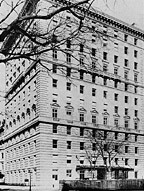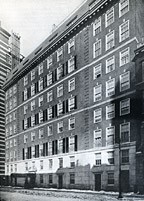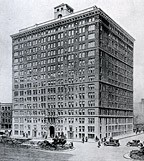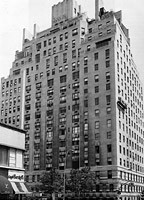Mott Schmidt Biography
- Featured Architecture:
- ABOUT MOTT SCHMIDT
- Introduction
- Beginnings and Sutton Place
- Townhouses and Apartments
- Country Houses
- Late Works
- Townhouses
- Sutton Place
- Anne Morgan Townhouse
- Mrs W.K. Vanderbilt Townhouse
- Guy Fairfax Cary Townhouse
- Miss Emily Trevor Townhouse
- Vincent Astor Townhouse
- Walter E. Hope Townhouse
- Apartment Houses
- 53 East 66th Street
- 1088 Park Avenue
- 19 East 72nd Street
- Country Houses
- Mr & Mrs Clarence Dillon Summer House
- Pook's Hill: Mr & Mrs Mott B. Schmidt Country House
- Marienruh: Mrs Serge Obolensky Country House
- Mr & Mrs Bernard Peyton Country House
- C. Douglas Dillon Country House
- Hudson Pines: Mrs David M. Milton Abby Rockefeller Country House
- Hillcrest: Mrs Martha Baird Rockefeller Country House
- Municipal Buildings
- Municipal Building and Post Office, Mount Kisco
- Susan B. Wagner Wing, Gracie Mansion
- Other Buildings
- French City Village Houses
- Selected Commissions for the Rockefeller Family
by Mark Alan Hewitt
- The Georgian Townhouse
- Cary and Trevor Townhouses
- Astor and Dillon Townhouses
- Apartment Buildings
- French City Village
- A Lasting Testament
Schmidt's success in the twenties brought in several commissions for
urban multi-family housing. The same forces which shaped his townhouse designs
can be seen in the three large apartment buildings he completed between 1924
and 1937. Again, these followed models created by McKim, Mead & White
(Figure 16) and Charles Platt, and apartment houses developed by specialists
such as J. E. R. Carpenter during the 1920s. Schmidt's first essay in this
building type is at 53 East 66th Street (1924-25) (Figure 17). It is
easy to imagine him conceiving of this nine-story, Georgian apartment house as
if it were simply a large townhouse. The basic components are the
same: a brick superstructure on a limestone base, a cornice and a slightly
projecting center mass. The major decorative elements are limited to the three
flat string courses dividing the building into horizontal layers of two-floor
increments; rustication defining the projecting center mass; and two modest
entrances, one of which has a split pediment. The strong suggestion of a
central focus made by the projecting mass is effectively countered by the
off-center entrance. With the bold string courses, the white keystones which
highlight the full extent of the facade, and the monochrome brick wall, one can
feel Schmidt striving to reduce the design to the fewest possible elements in
order to balance the mass and detail. Considering the uniformity of the facade,
the interior is surprisingly diverse, with apartments ranging from four to ten
rooms. The interlocking apartments arranged around a light court look very much
like the plan of a Schmidt townhouse.
In
1925 Schmidt designed the finest of his apartment houses, located at 1088 Park
Avenue between East 88th and 89th Streets (Figure
18). This building was one of New York's first cooperative apartment
buildings, and it contains a particularly delightful garden courtyard. The
facade and overall plan come directly from Charles Platt's influential Astor
Court (1914-15), across town at Broadway and 89th Street.
However, whereas Platt's U-shaped, palazzo-type building occupied half a city
block, Schmidt's site was limited to a single corner, thereby producing an
L-shaped plan. This interior arrangement follows a common model for upper-class
apartment configurations, including servant accommodations and a suite of
formal rooms off a double-loaded corridor. Each floor contains five ample
apartments. Of particular note are the spacious vaulted lobbies and vestibule
on the ground floor, with large arched glass doors opening onto the courtyard.
A garden frames the whimsical Italian Mannerist fountain at the back, a reverse
arrangement to Platt's garden the Astor Court. Outside, the characteristically
austere building is enlivened by more Mannerist details, such as the
"grotesque" keystone above the main entrance, and the giant-scale
modillion cornice. To further relieve the large, flat surface, Schmidt followed
Platt in subdividing the facade horizontally with four robust string courses.
Diverging from the model, he gave the window units an irregular staccato rhythm
(based upon the apartment plans within) and framed the entrance with a
two-story rusticated arch.
Schmidt's third apartment building was designed with Rosario Candela,
one of the most prolific of New York's apartment house architects (he built
nineteen apartment houses on Fifth Avenue alone.) Built in 1937 on
one of the most prestigious intersections in New York, Madison Avenue and 72nd
Street, this limestone clad building is one of the architect's few departures
from a traditional classical or Georgian vocabulary (Figure 19). Rising upward
in a series of setbacks like the towers of Rockefeller Center, the building
betrays a clear Art Deco influence, while also echoing the massing and materials
of Charles Platt's 1930-31 Astor Apartment house at 120 East End Avenue. The
three-story base is banded by a continuous double-cyma molding which forms the
spandrel within which windows of various sizes are placed. A powerful tension
results between windows, the upper and lower parts of the base, and the
molding. At the two-story entrance, curved stone profiles penetrate the mass on
a diagonal and direct one to the front doors, over which floats a relief
sculpture by C. P. Jennewein. The flamboyant base and massive superstructure
are unified by monochromatic materials, emphasizing the unity of the whole
rather than the diversity of the parts.



